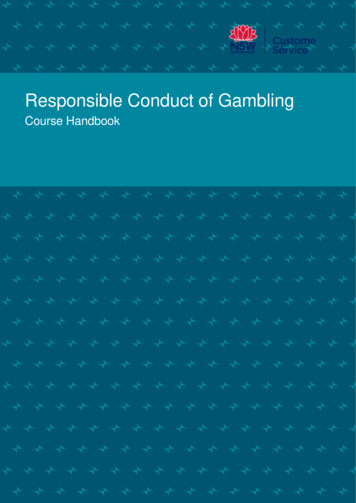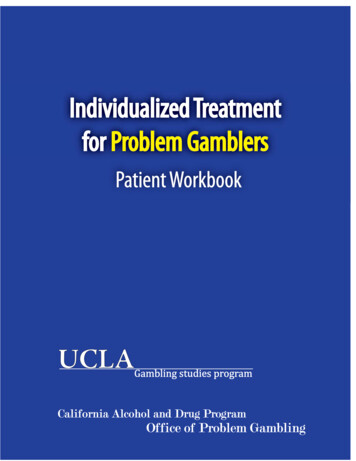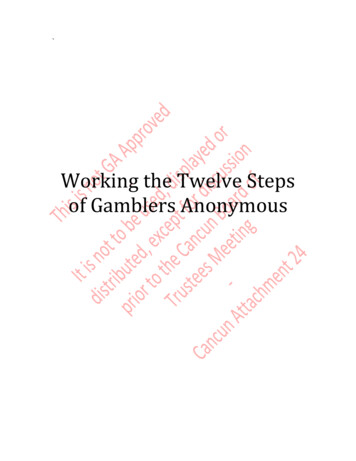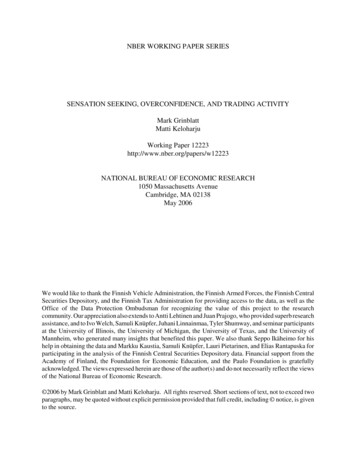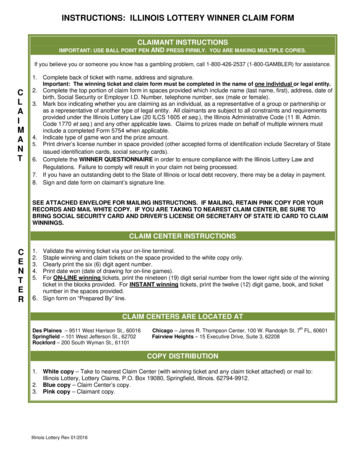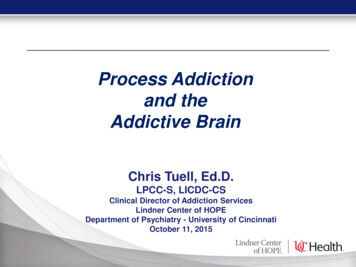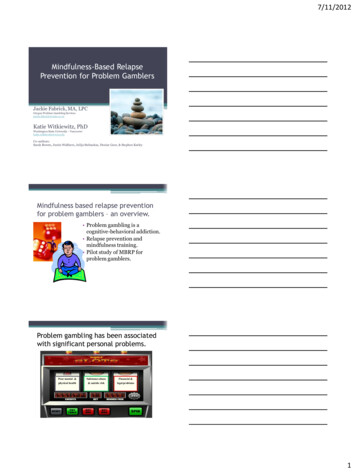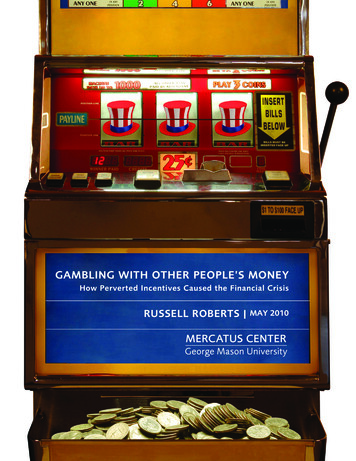
Transcription
GAMBLING WITH OTHER PEOPLE’S MONEYHow Perverted Incentives Caused the Financial CrisisRUSSELL ROBERTS MAY 2010
Russell RobertsRuss Roberts is a professor of economics at George Mason University, the J. Fish and LillianF. Smith Distinguished Scholar at the Mercatus Center, and a research fellow at StanfordUniversity’s Hoover Institution.His latest book is The Price of Everything: A Parable of Possibility and Prosperity, a novel abouthow prosperity is created and sustained and the unseen order and harmony that shape our dailylives. His other books are The Invisible Heart: An Economic Romance, a novel that discusses anarray of public-policy issues, including corporate responsibility, consumer safety, and welfare, andThe Choice: A Fable of Free Trade and Protectionism, which was named one of the top ten books ofthe year by Business Week and one of the best books of the year by the Financial Times when it wasfirst published in 1994.Roberts is the host of the weekly podcast series EconTalk and blogs at Cafe Hayek. His rap videowith John Papola on Keynes and Hayek, “Fear the Boom and Bust,” has over one million views onYouTube and has been subtitled in ten languages.Roberts is a frequent commentator on National Public Radio’s Morning Edition and All ThingsConsidered. In addition to numerous academic publications, he has written for the New YorkTimes and The Wall Street Journal. He is a founding advisory board member of the Library ofEconomics and Liberty.
GAMBLING WITH OTHER PEOPLE’S MONEY:How Perverted Incentives Caused the Financial CrisisEXECUTIVE SUMMARYBeginning in the mid-1990s, home prices in many American cities began a decade-longclimb that proved to be an irresistible opportunity for investors. Along the way, a lotof people made a great deal of money. But by the end of the first decade of the twentyfirst century, too many of these investments turned out to be much riskier than manypeople had thought. Homeowners lost their houses, financial institutions imploded,and the entire financial system was in turmoil.How did this happen? Whose fault was it? Some blame capitalism for being inherentlyunstable. Some blame Wall Street for its greed, hubris, and stupidity. But greed, hubris,and stupidity are always with us. What changed in recent years that created such adestructive set of decisions that culminated in the collapse of the housing market andthe financial system?In this paper, I argue that public-policy decisions have perverted the incentives thatnaturally create stability in financial markets and the market for housing. Over the lastthree decades, government policy has coddled creditors, reducing the risk they facefrom financing bad investments. Not surprisingly, this encouraged risky investmentsfinanced by borrowed money. The increasing use of debt mixed with housing policy,monetary policy, and tax policy crippled the housing market and the financial sector.Wall Street is not blameless in this debacle. It lobbied for the policy decisions thatcreated the mess.My understanding of the issues in this paper was greatly enhanced and influenced by numerous conversations with Sam Eddins, Dino Falaschetti, Arnold Kling, and Paul Romer. I am grateful to them fortheir time and patience. I also wish to thank Mark Adelson, Karl Case, Guy Cecala, William Cohan,Stephan Cost, Amy Fontinelle, Zev Fredman, Paul Glashofer, David Gould, Daniel Gressel, HeatherHambleton, Avi Hofman, Brian Hooks, Michael Jamroz, James Kennedy, Robert McDonald, ForrestPafenberg, Ed Pinto, Rob Raffety, Daniel Rebibo, Gary Stern, John Taylor, Jeffrey Weiss, and JenniferZambone for their comments and helpful conversations on various aspects of financial and monetarypolicy. I received helpful feedback from presentations to the Hoover Institution’s Working Group onGlobal Markets, George Mason University’s Department of Economics, and the Mercatus Center’sFinancial Markets Working Group. I am grateful for research assistance from Benjamin Klutsey and RyanLangrill. Any errors are my responsibility. In writing this paper, I’ve learned a little too much about howour financial system works. Unfortunately, I’m sure I still have much to learn. And as more of the factscome to light about the behavior of key players in the crisis, I’ll be commenting at my blog, Cafe Hayek,under the category “Gambling with Other People’s Money.”MERCATUS CENTER AT GEORGE MASON UNIVERSITYIn the United States we like to believe we are a capitalist society based on individualresponsibility. But we are what we do. Not what we say we are. Not what we wish tobe. But what we do. And what we do in the United States is make it easy to gamble withother people’s money—particularly borrowed money—by making sure that almosteverybody who makes bad loans gets his money back anyway. The financial crisis of2008 was a natural result of these perverse incentives. We must return to the naturalincentives of profit and loss if we want to prevent future crises.1
2GAMBLING WITH OTHER PEOPLE’S MONEY
CONTENTSExecutive Summary11. Introduction52. Gambling with Other People’s Money73. Did Creditors Expect to Get Rescued?9Figure 1: The Annual Cost to Buy Protection against Default on 10 Million of Lehman Debt for Five Years134. What about Equity Holders?155. Heads—They Win a Ridiculously Enormous Amount. Tails—They WinJust an Enormous Amount15with Regulation to Blow Up the Housing Market19Figure 2: S&P/Case-Shiller House Price Indices,1991–2009 (1991 Q1 100)217. Fannie and Freddie22Figure 3: Issuance of Mortgage-Backed Securities, 1989–2009(Billions of Dollars)227A. It’s Alive!23Figure 4: Combined Earnings of Fannie and Freddie, 1971–2007(Billions of 2009 Dollars)25Figure 5: Home-Purchase Loans Bought by GSEs, 1996–200726Figure 6: Total Home-Purchase Loans Bought by GSEs forBelow-Median-Income Buyers, 1996–200727Figure 7: Total Home-Purchase Loans Bought by GSEs withGreater than 95% Loan-to-Value Ratios28Figure 8: Owner-Occupied Home Loans with Less than5 Percent Down Purchased by Fannie and Freddie per Year297B. What Steering the Conduit Really Did308. Fannie and Freddie—Cause or Effect?319. Commercial and Investment Banks33Figure 9: Value of Subprime and Alt-A Mortgage Originations(Billions of Dollars)3410. Picking Up Nickels3511. Basel—Faulty3612. Where Do We Go from Here?37MERCATUS CENTER AT GEORGE MASON UNIVERSITY6. How Creditor Rescue and Housing Policy Combined3
4GAMBLING WITH OTHER PEOPLE’S MONEY
President George W. Bush,talking to Ben Bernanke and Henry Paulson whentold it was necessary to bail out AIG1The curious task of economics is to demonstrate to menhow little they really know about what they imaginethey can design.F. A. Hayek21. INTRODUCTIONBeginning in the mid-1990s, home prices in manyAmerican cities began a decade-long climb that provedto be an irresistible opportunity for investors.Along the way, a lot of people made a great dealof money. But by the end of the first decade of thetwenty-first century, too many of these investmentsturned out to be much riskier than many people hadthought. Homeowners lost their houses, financialinstitutions imploded, and the entire financial system was in turmoil.3How did this happen? Whose fault was it?A 2009 study by the U.S. Congressional ResearchService identified 26 causes of the crisis.4 TheFinancial Crisis Inquiry Commission is studying 22different potential causes of the crisis.5 In the face ofsuch complexity, it is tempting to view the housingcrisis and subsequent financial crisis as a once-ina-century coincidental conjunction of destructiveforces. As Alan Schwartz, Bear Stearns’s last CEO,put it, “We all [messed] up. Government. Ratingagencies. Wall Street. Commercial banks. Regulators.Investors. Everybody.”6In this commonly held view, the housing marketcollapse and the subsequent financial crisis were aperfect storm of private and public mistakes. Peoplebought houses they couldn’t afford. Firms bundledthe mortgages for these houses into complex securities. Investors and financial institutions bought thesesecurities thinking they were less risky than theyactually were. Regulators who might have preventedthe mess were asleep on the job. Greed and hubrisran amok. Capitalism ran amok.To those who accept this narrative, the lesson isclear. As Paul Samuelson put it,And today we see how utterly mistaken wasthe Milton Friedman notion that a marketsystem can regulate itself. We see how silly1. James Stewart, “Eight Days,” New Yorker, September 21, 2009.2. F. A. Hayek, The Fatal Conceit: The Errors of Socialism, ed. W.W. Bartley III (Chicago: University of Chicago Press, 1988), 76.3. Two very useful overviews of the crisis include Martin Neil Baily, Robert E. Litan, and Matthew S. Johnson, The Origins of the FinancialCrisis, Fixing Finance Series Paper 3 (Washington, DC: Brookings Institution, November 2008) and Arnold Kling, Not What They Had in Mind:A History of Policies That Produced the Financial Crisis of 2008 (Arlington, VA: Mercatus Center, September 2008). See also James R. Barthand others, The Rise and Fall of the U.S. Mortgage and Credit Markets: A Comprehensive Analysis of the Meltdown (Santa Monica, CA:Milken Institute, 2009). Two prescient analyses that were written without the benefit of hindsight and that influenced my thinking are GaryStern and Ron Feldman, Too Big to Fail: The Hazards of Bank Bailouts (Washington, DC: Brookings Institution, 2004); and Joshua Rosner,“Housing in the New Millennium: A Home without Equity Is Just a Rental with Debt” (working paper, Graham Fisher & Co., June 29, 2001).4. Mark Jickling, “Causes of the Financial Crisis” (Washington, DC: U.S. Congressional Research Service, January 29, 2009), available athttp://ssrn.com/abstract 1162456.5. The Financial Crisis Inquiry Commission is a bipartisan commission created in May 2009 to “examine the causes, domestic and global, ofthe current financial and economic crisis in the United States.”6. Quoted in William Cohan, House of Cards: A Tale of Hubris and Wretched Excess on Wall Street (New York: Doubleday, 2009), 450. Thebracketed edit is my own substitution to make suitable reading for family consumption.MERCATUS CENTER AT GEORGE MASON UNIVERSITYSomeday you guys are going to have to tell me how weended up with a system like this. I know this is not thetime to test them and put them through failure, butwe’re not doing something right if we’re stuck withthese miserable choices.5
the Ronald Reagan slogan was that government is the problem, not the solution. Thisprevailing ideology of the last few decadeshas now been reversed. Everyone understands now, on the contrary, that there canbe no solution without government.7The implication is that we need to reject unfetteredcapitalism and embrace regulation. But Wall Streetand the housing market were hardly unfettered.Yes, deregulation and misregulation contributed tothe crisis, but mainly because public policy over thelast three decades has distorted the natural feedbackloops of profit and loss. As Milton Friedman liked topoint out, capitalism is a profit and loss system. Theprofits encourage risk taking. The losses encourageprudence. When taxpayers absorb the losses, the distorted result is reckless and imprudent risk taking.GAMBLING WITH OTHER PEOPLE’S MONEYA different mistake is to hold Wall Street and thefinancial sector blameless, for after all, investmentbankers and other financial players were just doingwhat they were supposed to do—maximizing profits and responding to the incentives and the rules ofthe game. But Wall Street helps write the rules of thegame. Wall Street staffs the Treasury Department.Washington staffs Fannie Mae and Freddie Mac. Inthe week before the AIG bailout that put 14.9 billion into the coffers of Goldman Sachs, TreasurySecretary and former Goldman Sachs CEO HenryPaulson called Goldman Sachs CEO Lloyd Blankfeinat least 24 times.8 I don’t think they were talkingabout how their kids were doing.6This paper explores how changes in the rules of thegame—some made for purely financial motives, somemade for more altruistic reasons—created the messwe are in.The most culpable policy has been the systematicencouragement of imprudent borrowing and lending. That encouragement came not from capitalismor markets, but from crony capitalism, the mutual aidsociety where Washington takes care of Wall Streetand Wall Street returns the favor.9 Over the last threedecades, public policy has systematically reducedthe risk of making bad loans to risky investors. Overthe last three decades, when large financial institutions have gotten into trouble, the government hasalmost always rescued their bondholders and creditors. These policies have created incentives both toborrow and to lend recklessly.When large financial institutions get in trouble,equity holders are typically wiped out or made tosuffer significant losses when share values plummet.The punishment of equity holders is usually thoughtto reduce the moral hazard created by the rescue ofcreditors. But it does not. It merely masks the role ofcreditor rescues in creating perverse incentives forrisk taking.The expectation by creditors that they might be rescued allows financial institutions to substitute borrowed money for their own capital even as they makeriskier and riskier investments. Because of the largeamounts of leverage—the use of debt rather thanequity—executives can more easily generate shortterm profits that justify large compensation. Whileexecutives endure some of the pain if short-termgains become losses in the long run, the downsiderisk to the decision-makers turns out to be surprisingly small, while the upside gains can be enormous.Taxpayers ultimately bear much of the downsiderisk. Until we recognize the pernicious incentivescreated by the persistent rescue of creditors, no regulatory reform is likely to succeed.7. Paul Samuelson, “Don’t Expect Recovery Before 2012—With 8% Inflation,” interview by Nathan Gardels, New Perspectives Quarterly 27(Spring 2009).8. Gretchen Morgenson and Don Van Natta Jr., “Paulson’s Calls to Goldman Tested Ethics,” New York Times, August 8, 2009.9. Here is one tally of Goldman Sachs’s revolving door with the government: McClatchy DC, “A Revolving Door,” media.mcclatchydc.com,October 28, 2009. See also Kate Kelly and Jon Hilsenrath, “New York Chairman’s Ties to Goldman Raise Questions,” Wall Street Journal, May 4,2009. And one look at the money flows from Wall Street to Washington is “Among Bailout Supporters, Wall St. Donations Ran High,” New YorkTimes, September 30, 2008.
In the United States we like to believe we are a capitalist society based on individual responsibility.But we are what we do. Not what we say we are.Not what we wish to be. But what we do. And whatwe do is make it easy to gamble with other people’s money—particularly borrowed money—by makingsure that almost everybody who makes bad loans getshis money back anyway. The financial crisis of 2008was a natural result of these perverse incentives.2. GAMBLING WITH OTHERPEOPLE’S MONEYImagine a superb poker player who asks you for aloan to finance his nightly poker playing.10 For every 100 he gambles, he’s willing to put up 3 of his ownmoney. He wants you to lend him the rest. You willnot get a stake in his winning. Instead, he’ll give youa fixed rate of interest on your 97 loan.The poker player likes this situation for two reasons. First, it minimizes his downside risk. He canonly lose 3. Second, borrowing has a great effecton his investment—it gets leveraged. If his 100 betends up yielding 103, he has made a lot more than3 percent—in fact, he has doubled his money. His 3investment is now worth 6.But why would you, the lender, play this game? It’s apretty risky game for you. Suppose your friend startsout with a stake of 10,000 for the night, putting up 300 himself and borrowing 9,700 from you. If heloses anything more than 3 percent on the night, hecan’t make good on your loan.Not to worry—your friend is an extremely skilledand prudent poker player who knows when to hold,,em and when to fold em. He may lose a hand or twobecause poker is a game of chance, but by the end ofthe night, he’s always ahead. He always makes goodon his debts to you. He has never had a losing evening. As a creditor of the poker player, this is all youcare about. As long as he can make good on his debt,you’re fine. You care only about one thing—that hestays solvent so that he can repay his loan and you getyour money back.But the gambler cares about two things. Sure, hetoo wants to stay solvent. Insolvency wipes out hisinvestment, which is always unpleasant—it’s bad forhis reputation and hurts his chances of being able touse leverage in the future. But the gambler doesn’tjust care about avoiding the downside. He also caresabout the upside. As the lender, you don’t share inthe upside; no matter how much money the gamblermakes on his bets, you just get your promised amountof interest.If there is a chance to win a lot of money, the gambleris willing to a take a big risk. After all, his downside issmall. He only has 3 at stake. To gain a really largepot of money, the gambler will take a chance on aninside straight.10. I want to thank Paul Romer for the poker analogy, which is much better than my original idea of using dice. He also provided the quoteabout the “sucker at the table” that I use later.MERCATUS CENTER AT GEORGE MASON UNIVERSITYAlmost all of the lenders who financed bad bets inthe housing market paid little or no cost for theirrecklessness. Their expectations of rescue were confirmed. But the expectation of creditor rescue was notthe only factor in the crisis. As I will show, housingpolicy, tax policy, and monetary policy all contributed, particularly in their interaction. Though otherfactors—the repeal of the Glass-Steagall Act, predatory lending, fraud, changes in capital requirements,and so on—made things worse, I focus on creditorrescue, housing policy, tax policy, and monetary policy because without these policies and their interaction, the crisis would not have occurred at all. Andamong causes, I focus on creditor rescue and housingpolicy because they are the most misunderstood.7
As the lender of the bulk of his funds, you wouldn’twant the gambler to take that chance. You know thatwhen the leverage ratio—the ratio of borrowed fundsto personal assets—is 32–1 ( 9700 divided by 300),the gambler will take a lot more risk than you’d like.So you keep an eye on the gambler to make sure thathe continues to be successful in his play.But suppose the gambler becomes increasingly reckless. He begins to draw to an inside straight fromtime to time and pursue other high-risk strategiesthat require making very large bets that threaten hisability to make good on his promises to you. After all,it’s worth it to him. He’s not playing with very muchof his own money. He is playing mostly with yourmoney. How will you respond?GAMBLING WITH OTHER PEOPLE’S MONEYYou might stop lending altogether, concerned thatyou will lose both your interest and your principal.Or you might look for ways to protect yourself. Youmight demand a higher rate of interest. You mightask the player to put up his own assets as collateralin case he is wiped out. You might impose a covenantthat legally restricts the gambler’s behavior, barringhim from drawing to an inside straight, for example.8These would be the natural responses of lendersand creditors when a borrower takes on increasingamounts of risk. But this poker game isn’t proceedingin a natural state. There’s another person in the room:Uncle Sam. Uncle Sam is off in the corner, keepingan eye on the game, making comments from time totime, and, every once in a while, intervening in thegame. He sets many of the rules that govern the playof the game. And sometimes he makes good on thedebt of the players who borrow and go bust, takingcare of the lenders. After all, Uncle Sam is loaded. Hehas access to funds that no one else has. He also likesto earn the affection of people by giving them money.Everyone in the room knows Uncle Sam is loaded,and everyone in the room knows there is a chance,perhaps a very good chance, that wealthy Uncle Samwill cover the debts of players who go broke.Nothing is certain. But the greater the chance thatUncle Sam will cover the debts of the poker player ifhe goes bust, the less likely you are to try to restrainyour friend’s behavior at the table. Uncle Sam’s interference has changed your incentive to respond whenyour friend makes riskier and riskier bets.If you think that Uncle Sam will cover your friend’sdebts . . .you will worry less and pay less attention to therisk-taking behavior of your gambler friend.you will not take steps to restrain reckless risktaking.you will keep making loans even as his bets getriskier.you will require a relatively low rate of interestfor your loans.you will continue to lend even as your gamblerfriend becomes more leveraged.you will not require that your friend put inmore of his own money and less of yours as hemakes riskier and riskier bets.What will your friend do when you behave this way?He’ll take more risks than he would normally. Whywouldn’t he? He doesn’t have much skin in the gamein the first place. You do, but your incentive to protect your money goes down when you have UncleSam as a potential backstop.Capitalism is a profit and loss system. The profits encourage risk taking. The losses encourage prudence. Eliminate losses or even raise the chancethat there will be no losses and you get less prudence.So when public decisions reduce losses, it isn’t surprising that people are more reckless.Who got to play with other people’s money in the yearspreceding the crisis? Who was highly leveraged—putting very little of his own money at risk while borrowing the rest? Who was able to continue to borrowat low rates even as he made riskier and riskier bets?Who sat at the poker table?Just about everybody.
Without extreme leverage, the housing meltdownwould have been like the meltdown in high-tech stocksin 2001—a bad set of events in one corner of a verylarge and diversified economy.11 Firms that investedin that corner would have had a bad quarter or a badyear. But because of the amount of leverage that wasused, the firms that invested in housing—Fannie Maeand Freddie Mac, Bear Stearns, Lehman Brothers,Merrill Lynch, and others—destroyed themselves.So why did it happen? Did bondholders and lenders really believe that they would be rescued if theirinvestments turned out to be worthless? Were theexpectations of a bailout sufficiently high to reducethe constraints on leverage? And even though itis pleasant to gamble with other people’s money,wasn’t a lot of that money really their own? Even ifbondholders and lenders didn’t restrain the recklessness of those to whom they lent, why didn’t stockholders—who were completely wiped out in almostevery case, losing their entire investments—restrainrecklessness? Sure, bondholders and lenders careonly about avoiding the downside. But stockholdersdon’t care just about the upside. They don’t want tobe wiped out, either. The executives of Fannie Mae,Freddie Mac, and the large investment banks heldmillions, sometimes hundreds of millions of theirown wealth in equity in their firms. They didn’t wantto go broke and lose all that money. Shouldn’t thathave restrained the riskiness of the bets that thesefirms took?3. DID CREDITORS EXPECT TOGET RESCUED?Was it reasonable for either investors or theircreditors to expect government rescue? 12 Whilethere were government bailouts of Lockheed andChrysler in the 1970s, the recent history of rescuing large, troubled financial institutions begins in1984, when Continental Illinois, then one of the topten banks in the United States, was rescued beforeit could fail. The story of its collapse sounds all toofamiliar—investments that Continental Illinois hadmade with borrowed money turned out to be riskierthan the market had anticipated. This caused whatwas effectively a run on the bank, and ContinentalIllinois found itself unable to cover its debts withnew loans.In the government rescue, the government took on 4.5 billion of bad loans and received an 80 percentequity share in the bank. Only 10 percent of the bank’sdeposits were insured, but every depositor was covered in the rescue.13 Eventually, equity holders werewiped out.11. Many economists, including this one, grossly underestimated the potential impact of the subprime crisis because we did not understandthe extent or impact of leverage. Mea culpa.12. The policy of government bailout is usually called “too big to fail.” But government occasionally lets large financial institutions fail. As Ishow below, the government almost always makes sure that creditors get all the money they were promised. The rescue of creditors is whatcreates excessive leverage and removes the incentive of the one group—creditors—that should have an incentive to monitor recklessness.See Stern & Feldman, Too Big to Fail and Gary Stern, interview by Russell Roberts, “Stern on Too Big to Fail,” Econtalk podcast, October 5,2009. See also Nicole Gelinas, “‘Too Big to Fail’ Must Die,” City Journal 19 no.3 (Summer 2009).13. See Robert L. Hetzel, “Too Big to Fail: Origins, Consequences, and Outlook,” Economic Review (November/December 1991).MERCATUS CENTER AT GEORGE MASON UNIVERSITYHomebuyers. The government-sponsored enterprises (GSEs)—Fannie Mae and Freddie Mac. Thecommercial banks—Bank of America, Citibank,and many others. The investment banks—like BearStearns and Lehman Brothers. Everyone was playingthe same game, playing with other people’s money.They were all able to continue borrowing at the samelow rates even as the bets they placed grew riskierand riskier. Only at the very end, when collapse wasimminent and there was doubt about whether UncleSam would really come to the rescue, did the playersat the table find it hard to borrow and gamble withother people’s money.9
In congressional testimony after the rescue, thecomptroller of the currency implied that there wereno attractive alternatives to such rescues if the 10or 11 largest banks in the United States experiencedsimilar problems.14 The rescue of Continental Illinoisand the subsequent congressional testimony sent asignal to the poker players and those that lend tothem that lenders might be rescued.Continental Illinois was just the largest and mostdramatic example of a bank failure in which creditors were spared any pain. Irvine Sprague, in his 1986book Bailout noted,Of the fifty largest bank failures in history,forty-six—including the top twenty—werehandled either through a pure bailout or anFDIC assisted transaction where no depositor or creditor, insured or uninsured, losta penny.15GAMBLING WITH OTHER PEOPLE’S MONEYThe 50 largest failures up to that time all took placein the 1970s and 1980s. As the savings and loan (S&L)crisis unfolded during the 1980s, government repeatedly sent the same message: lenders and creditorswould get all of their money back. Between 1979and 1989, 1,100 commercial banks failed. Out of allof their deposits, 99.7 percent, insured or uninsured,were reimbursed by policy decisions.1610The next event that provided information to thepoker players was the collapse of Drexel Burnhamin 1990.17 Drexel Burnham lobbied the governmentfor a guarantee of its bad assets that would allow asuitor to find the company attractive. But Drexelwent bankrupt with no direct help from the government. The failure to rescue Drexel put some threat ofloss back into the system, but maybe not very much—Drexel Burnham was a political pariah. The firm andits employees had numerous convictions for securities fraud and other violations.In 1995 there was another rescue, not of a financial institution, but of a country—Mexico. TheUnited States orchestrated a 50 billion rescueof the Mexican government, but as in the case ofContinental Illinois, it was really a rescue of thecreditors, those who had bought Mexican bonds andwho faced large losses if Mexico were to default. AsCharles Parker details in his 2005 study, Wall Streetinvestment banks had strong interests in Mexico’sfinancial health (because of future underwritingfees) and held significant amounts of Mexican bondsand securities.18 Despite opposition from Main Streetand numerous politicians, policy makers put togetherthe rescue in the name of avoiding a financial crisis.Ultimately, the U.S. Treasury got its money back andeven made a modest profit, causing some to deem therescue a success. It was a success in fiscal terms. Butit encouraged lenders to finance risky bets withoutfear of the consequences.Willem Buiter, then an economics professor at theUniversity of Cambridge and now the chief economist at CitiGroup, was quoted at the time:This is not a great incentive for efficientoperations of financial markets, becausepeople do not have to weigh carefully riskagainst return. They’re given a one-way bet,with the U.S. Treasury and the internationalcommunity underwriting the default risk.That makes for lazy private investors whodon’t have to do their homework figuringout what the risks are.1914. House Subcommittee on Financial Institutions Supervision, Regulation and Insurance of the Committee on Banking, Finance, and UrbanAffairs, Inquiry into Continental Illinois Corp. and Continental Illinois National Bank, 98th Cong., 2d sess., 1984.15. Irvine Sprague, Bailout: An Insider’s Account of Bank Failures and Rescues (New York: Basic Books, 1986), 242.16. Stern and Feldman, Too Big to Fail, 12. They do not provide data on what proportion of these deposits was uninsured.17. See “Predator’s Fall: Drexel Burnham Lambert,” Time, February 26, 1990.18. Charles W. Parker III, “International Investor Influence in the 1994–1995 Mexican Peso Crisis” (working paper, Columbia InternationalAffairs Online, Columbia University, 2005).19. Willem Buiter quoted in Carl Gewirtz, “Mexico: Why Save Speculators?
other people’s money—particularly borrowed money—by making sure that almost everybody who makes bad loans gets his money back anyway. The financial crisis of 2008 was a natural result of these perverse incentives. We must return to the natural incentive

